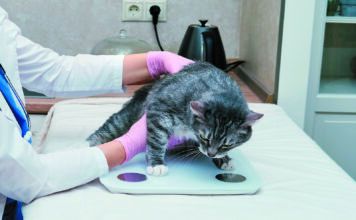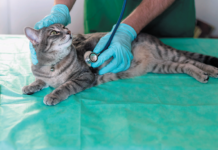Is it Dangerous to Let Your Cat Sleep in Your Bed?
A number of years ago, researchers reported the case of a New Mexico boy who ended up with bubonic plague after he let his cat share his bed. It turned out the cat was infested with fleas who carried the disease, and the boy ended up with flea bites. Another woman who let her cat lick her awake every morning ended up with a serious sinus infection. Yet someone else developed lesions and itchiness on her trunk and arms after her cat, infested with mites, slept in her bed; she was diagnosed with a parasitic infection known as Cheyletiella blakei.
July 4th: Your Cat’s Least Favorite Holiday
It’s not just the booms of the fireworks that cats hate. It’s the comings and goings of people attending your barbecue, the overall differentness of the day. Cats derive so much comfort from things being predictable. When the flow of daily events is thrown off, your pet is thrown off, too. Here’s how to make the holiday more bearable for your feline family member.
Are NSAIDs the Right Choice for Long-Term Use in Cats?
When it comes to people, long-term use of nonsteroidal anti-inflammatory drugs (NSAIDs) like aspirin and ibuprofen are often thought of as problematic because they can cause problems ranging from a tendency to bleed too easily to stomach ulcers. There can be risks to the heart and brain, too. That said, under a doctor’s supervision, NSAIDs are sometimes prescribed to deal with chronic pain—pain that is not going to subside in a short time.
A feline high from second-hand marijuana smoke?
Q: Sometimes marijuana is smoked recreationally in our home, and I am worried as our cat does not seem herself when that happens. Am I imagining it, or could there really be some effects?
Should Your Cat Be an Indoor Pet or Indoor/Outdoor?
It’s often said that the best life for a pet cat is entirely indoors because that will keep her safest. But the new 2024 Position Statement on indoor/outdoor lifestyle from the American Academy of Feline Practitioners (AAFP) makes it clear that the truth is more nuanced.
Download The Full June 2024 Issue PDF
- For How Long Can a Cat Food be “New” and “Improved”?
- Morsels
- 3 Easy-to-Miss Signs of Feline Fear
- Veterinary Chaplaincy Edges Towards the Mainstream
- How Concerned Should You Be about Lumps and Bumps on Your Cat’s Coat?
- What It Means When a Cat Throws a Clot
- Dear Doctor: Vaccine Confusion
What It Means When a Cat Throws a Clot
One minute your cat seems fine, and the next, she’s paralyzed in her hind legs and is crying out in great pain, dragging herself around by her front limbs. What’s going on?
Telemedicine for Your Cat, or In-Person Care?
The COVID pandemic led to more Zooming and FaceTiming, including for veterinary care. And it may be easy to assume that most people have come to prefer such virtual vet visits because it’s more convenient and less stressful than taking your cat to the doctor. But they don’t.
Veterinary Chaplaincy Edges Towards the Mainstream
Grief shared is grief abated.
The Scratching Post Materials Cats Like Best
Cardboard? Jute? Hemp? What’s the best material for your cat’s scratching post? Cats will vary in their preferences, but research suggests it’s hard to go wrong with either sisal rope for a cat who’s young or middle aged or carpet for a cat who’s older than 10.
Vaccine confusion
Q: There is a difference in vaccine recommendations for people and those for cats that I find confusing. With people, the interval between vaccinations varies depending on the shot. For instance, people get a shot against tetanus every 10 years and a shingles shot just once. But cats are supposed to get all their core vaccines once a year. Why is that? Does the immunity from the diseases the shots protect against always wane so quickly?
For How Long Can a Cat Food be “New” and “Improved”?
Have you ever seen the word “new” or “improved” on a cat food label? If so, it shouldn’t be there for more than the first six months of production. “It’s not new forever,” says the Association of American Feed Control Officials (AAFCO), whose guidelines are generally written into law by each state legislature.















